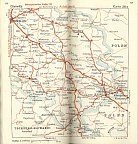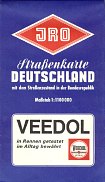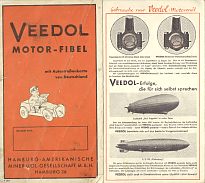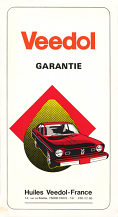VEEDOL
Brief History
Veedol's origins go back to 1887 when the Tidewater Oil Company was eastablished in New York; sometime before World War I it introduced the Veedol name on its lubricants. Veedol set up an office in Hamburg in 1925, and soon became a major force in lubricants in Germany, later expanding into other major European markets such as France, Italy, the Low Countries and on a smaller scale, the UK. In 1937, Tidewater/Veedol were acquired by J. Paul Getty from Standard Oil Company of New Jersey (Esso: which had gained control a few years earlier) but soon after 1970, the Getty Oil Company sold its European activities to Burmah. At that times its assets included the rights to the Veedol name and a refinery in Gaeta, Italy (which had an associated Getty branded service station. Burmah kept Veedol separate from its main Castrol brand, and the name was still in used in several countries after BP bought Burmah in 2000. As late as 2003 Veedol claimed to be the largest selling oil in workshops in Germany, but subsequently BP focused on its Castrol or Aral brands, and sold the global rights to the Veedol name in 2011 to its former Indian licensee Tide Water Oil.
Maps - Germany
 Front cover |
This early (1934?) small format cloth bound atlas had 35 double pages of maps by L Ravenstein. The atlas was bound in an unusual manner allowing the double page maps to be printed on a single leaf, folded (but not stitched or stapled). Overall there were 212 pages, with many listing all Veedol's German sales outlets and rather fewer showing how it lubricated engines. A letter of endorsement and photograph of the Graf Zeppelin was included, as well a photo of the car that had won the 1933 Indianapolis race. |
 Map 26a (Breslau-Gleiwitz) |
|
|
Three versions of this road map of Germany are known with minor cover changes. This example was issued in 1937 or 8 by Hamburg-Amerikanische Mineralöl GmbH (Veedol). While the road map by Georg Westermann is not overly detailed at 1:2,000,000, the map's rear provides a meticulous description of an internal combustion engine with special emphasis on the engine's lubrication needs. It also promotes Veedol's use in the Graf Zeppelin and Hindenburg - which was destroyed in an accident in May 1937. |
 |
 |
Long after the war, Veedol returned to producing maps for the German market, using stock JRO issues with customised covers - the rear cover carrying a Veedol motor oil advert. The first example (far left) is a sectional map of NW Germany at 1:750,000 apparently dating from 1964, although the rear cover ( right), showing the world-famous "Miss Veedol" on ice skates, refers to Veedol having been in existence for 85 years. |
 |
The Süd-Deutschland section from the same year was coloured light green and at the smaller scale of 1:750,000. The blue map is probably a year or two younger as the V on the logo lacks wings; it covered all of Germany at 1:1,100,000. Interestingly the earlier maps refer to Veedol Kraftstoffe (fuel, usually meaning petrol) as well as motor oils. These particular maps are stamped with the name of a KD-Tankstelle in Witten (Ruhr) on the reverse. It is not known if Veedol or KD branded petrol was ever sold at retail, or whether the filling station in question was simply an unbranded site. The reverse side of the maps themselves carried adverts for other JRO products, similar to those shown on the Lotherol page.
Maps - France
|
|
|
Text and layout © Ian Byrne, 2001-13
All original copyrights in logos and map extracts and images are acknowledged and images are included on this site for identification purposes only.



 Although Veedol was a strong player in several other markets, this French map is the only known example from outside Germany. Glossy card covers were used to cover a Recta-Foldex map, based on IGN designs. Although undated the map carries the code 6717, but road construction suggests it most likely dates from 1976. The car on the cover appears to be based on a Subaru Leone (possibly as it was only rarely seen in France), a model introduced in 1972.
Although Veedol was a strong player in several other markets, this French map is the only known example from outside Germany. Glossy card covers were used to cover a Recta-Foldex map, based on IGN designs. Although undated the map carries the code 6717, but road construction suggests it most likely dates from 1976. The car on the cover appears to be based on a Subaru Leone (possibly as it was only rarely seen in France), a model introduced in 1972.